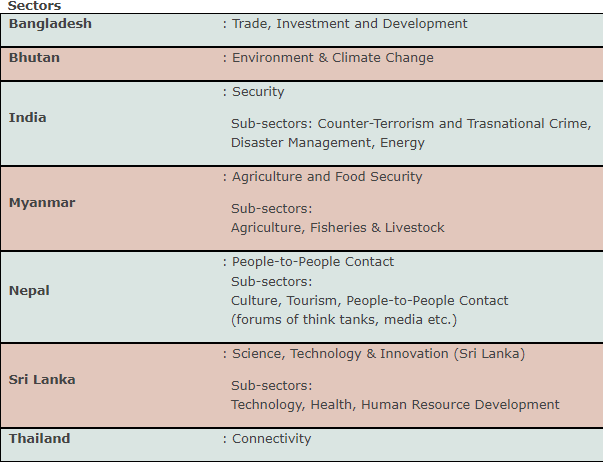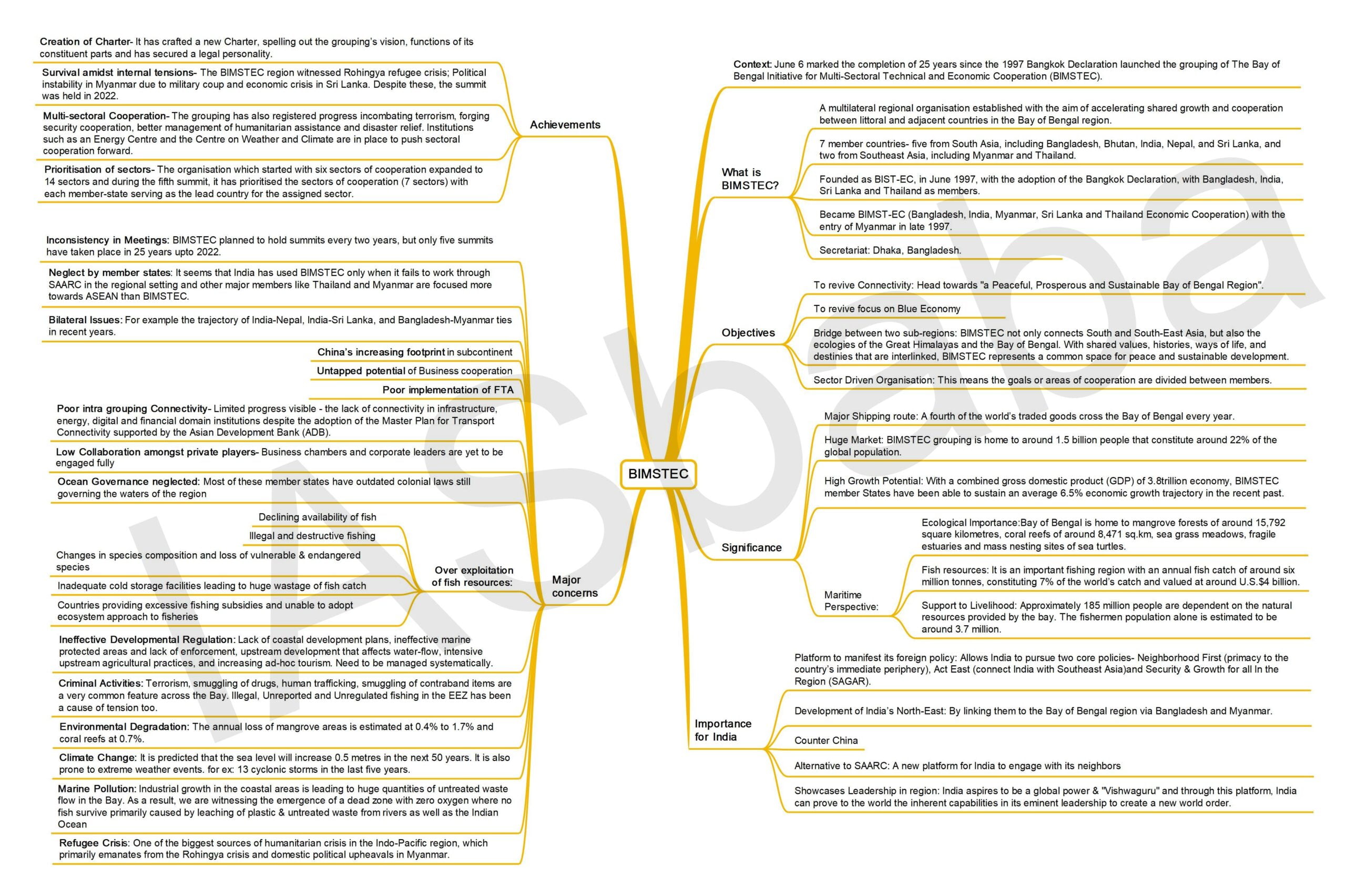International Relations
Syllabus
- GS-2: Bilateral, regional and global groupings and agreements involving India and/or affecting India’s interests.
Context: June 6 marked the completion of 25 years since the 1997 Bangkok Declaration launched the grouping of BIMSTEC.

- The Bay of Bengal Initiative for Multi-Sectoral Technical and Economic Cooperation (BIMSTEC) is a multilateral regional organisation established with the aim of accelerating shared growth and cooperation between littoral and adjacent countries in the Bay of Bengal region.
- It has a total of seven member countries- five from South Asia, including Bangladesh, Bhutan, India, Nepal, and Sri Lanka, and two from Southeast Asia, including Myanmar and Thailand.
- It was founded as BIST-EC, in June 1997, with the adoption of the Bangkok Declaration, with Bangladesh, India, Sri Lanka and Thailand as members.
- It became BIMST-EC (Bangladesh, India, Myanmar, Sri Lanka and Thailand Economic Cooperation) with the entry of Myanmar in late 1997.
- And eventually, it was named in its current form, when Nepal and Bhutan became members in 2004.
- It has its secretariat at Dhaka, Bangladesh.
- The BIMSTEC Secretariat coordinates, monitors and facilitates the implementation of BIMSTEC activities and programmes.
- The Bay of Bengal (Bay) is in the northeastern part of the Indian Ocean.
- It is bound by land on three sides;
- on the west and northwest by India
- on the north by Bangladesh
- on the east by Myanmar and the Andaman &Nicobar Islands of India.
- Its southern limit is a line between Sri Lanka and the northwestern-most point of Sumatra (Indonesia).
- Important ports on the Bay include Paradip, Kolkata, Haldia, Chennai, Visakhapatnam, Kakinada, Pondicherry, Dhamra, Gopalpur in India and Chittagong, Mongla, Payra Ports in Bangladesh.
- To revive Connectivity: The Bay of Bengal region, was one of the world’s most integrated regions until the early twentieth century, but after the 1940s, when members of the region became independent and pursued separate goals and alliance systems, the region’s sense of community eroded. So, the aim of setting up the regional grouping was to revive the connectivity and common interests of the members of the Bay of Bengal region.
- The shared goal now is to head towards “a Peaceful, Prosperous and Sustainable Bay of Bengal Region”.
- To revive focus on Blue Economy: The region, though united historically with a rich cultural heritage, but post decolonisation got impregnated with crimes like insurgency, terrorism, narcotics smuggling, trafficking, illegal immigration which prompted the member states to consider internal and border security issues on priority. Except for addressing security issues, development of the blue economy of the Bay of Bengal never received the required thrust. The grouping provides littoral countries to come together to exploit the potential of Blue economy that the region offers.
- Bridge between two sub-regions: BIMSTEC not only connects South and South-East Asia, but also the ecologies of the Great Himalayas and the Bay of Bengal. With shared values, histories, ways of life, and destinies that are interlinked, BIMSTEC represents a common space for peace and sustainable development.
- Sector Driven Organisation: What makes BIMSTEC different from other regional groupings such as SAARC or ASEAN is that it is a sector-driven organisation. This means the goals or areas of cooperation are divided between members.
Principles of BIMSTEC are:
- Sovereign Equality
- Territorial Integrity
- Political Independence
- No-interference in Internal Affairs
- Peaceful Co- existence
- Mutual Benefit
- Constitute an addition to and not be a substitute for bilateral, regional or multilateral cooperation involving the Member States.
- Major Shipping route: A fourth of the world’s traded goods cross the Bay of Bengal every year.
- Huge Market: BIMSTEC grouping is home to around 1.5 billion people that constitute around 22% of the global population.
- High Growth Potential: With a combined gross domestic product (GDP) of 3.8 trillion economy, BIMSTEC member States have been able to sustain an average 6.5% economic growth trajectory in the recent past.
- Ecological Importance: Bay of Bengal is home to mangrove forests of around 15,792 square kilometres, coral reefs of around 8,471 sq.km, sea grass meadows, fragile estuaries and mass nesting sites of sea turtles.
- Fish resources: It is an important fishing region with an annual fish catch of around six million tonnes, constituting 7% of the world’s catch and valued at around U.S.$4 billion.
- Support to Livelihood: Approximately 185 million people are dependent on the natural resources provided by the bay. The fishermen population alone is estimated to be around 3.7 million.
- Platform to manifest its foreign policy: BIMSTEC allows India to pursue two core policies- Neighborhood First (primacy to the country’s immediate periphery), Act East (connect India with Southeast Asia) and Security & Growth for all In the Region (SAGAR).
- Development of India’s North-East: The grouping also provides opportunity for economic development of India’s northeastern states – by linking them to the Bay of Bengal region via Bangladesh and Myanmar.
- Counter China: The grouping allows India to counter China’s creeping influence in countries around the Bay of Bengal due to the spread of its Belt and Road Initiative.
- Alternative to SAARC: A new platform for India to engage with its neighbors with South Asian Association for Regional Cooperation (SAARC) becoming dysfunctional because of differences between India and Pakistan.
- Showcases Leadership in region: India aspires to be a global power & “Vishwaguru” and through this platform, India can prove to the world the inherent capabilities in its eminent leadership to create a new world order.
- BIMSTEC Summit – highest policymaking body in BIMSTEC process and is comprised of heads of state/government of member states.
- Ministerial Meeting – second apex policy-making forum of BIMSTEC attended by the External/Foreign Ministers of Member States.
- Senior Officials’ Meeting – represented by Senior Officials of Foreign Ministries of the Member States.
- BIMSTEC Working Group – attended by Ambassadors of BIMSTEC Member Countries to Bangladesh or their representatives on a monthly basis at the BIMSTEC Secretariat in Dhaka.
- Business Forum & Economic Forum – the two important forums to ensure active participation of private sector.
BIMSTEC grouping’s fifth summit took place in Colombo, Sri Lanka in March 2022. The key highlights of the summit were
- BIMSTEC Charter: The signing of the BIMSTEC Charter was the main outcome of this summit. With the Charter, the BIMSTEC now has an international personality. It has an emblem and a flag.
- It has a formally listed purpose and principles that it is going to adhere to.
- Under this Charter, the members were expected to meet once every two years.
- Rationalising Sectors of Cooperation: In line with the development of the organisation into a formal structure, the leaders of the member-countries have agreed to divide the working of the grouping into seven segments, with India providing leadership to the security pillar (details of sectors given in achievements section)
- Connectivity Framework: The Summit adopted the ‘Master Plan for Transport Connectivity’ by Leaders which lays out a guidance framework for connectivity related activities in the region in the future.
- Other Agreements: Member countries also signed a treaty on mutual legal assistance on criminal matters.
- A Memorandum of Association (MoA) on the establishment of BIMSTEC Technology Transfer Facility (TTF) in Colombo, Sri Lanka.
- India will provide the (BIMSTEC) secretariat USD 1 million US dollars to increase its operational budget.
- Creation of Charter- It has crafted a new Charter for itself ( during its fifth Summit in 2022), spelling out the grouping’s vision, functions of its constituent parts and has secured a legal personality.
- Survival amidst internal tensions– The BIMSTEC region witnessed Rohingya refugee crisis; Political instability in Myanmar due to military coup and economic crisis in Sri Lanka. Despite these, the summit was held in 2022.
- Multi-sectoral Cooperation– The grouping has also registered progress in combating terrorism, forging security cooperation, better management of humanitarian assistance and disaster relief. Institutions such as an Energy Centre and the Centre on Weather and Climate are in place to push sectoral cooperation forward.
- Prioritisation of sectors– The organisation which started with six sectors of cooperation expanded to 14 sectors which was becoming unwieldy. However, during the fifth summit, it has prioritised the sectors of cooperation (7 sectors) with each member-state serving as the lead country for the assigned sector.

- Inconsistency in Meetings: BIMSTEC planned to hold summits every two years, ministerial meetings every year, but only five summits have taken place in 25 years upto 2022.
- Neglect by member states: It seems that India has used BIMSTEC only when it fails to work through SAARC in the regional setting and other major members like Thailand and Myanmar are focused more towards ASEAN than BIMSTEC.
- Bilateral Issues: A strong BIMSTEC presupposes cordial and tension-free bilateral relations among all its member-states. This has not been the case, given the trajectory of India-Nepal, India-Sri Lanka, and Bangladesh-Myanmar ties in recent years.
- China’s increasing footprint in subcontinent: China’s decisive intrusion in the South-Southeast Asian space has cast dark shadows about the cohesiveness of the grouping on issues like trade pacts, investments & security.
- Untapped potential of Business cooperation: It lacks an effort to enthuse and engage the vibrant business communities of these seven countries, and expand their dialogue, interactions and transactions.
- Poor implementation of FTA: A major failure relates to the continuing inability to produce a comprehensive Free Trade Agreement (FTA) 18 years after the signing of the Framework Agreement in 2004. Out of the seven agreements needed to operationalise the FTA, only two are ready.
- Poor intra grouping Connectivity– The connectivity in infrastructure, energy, digital and financial domain institutions that bring people closer together for trade, tourism and cultural exchanges is disappointing. Only limited progress has been achieved so far, despite the adoption of the Master Plan for Transport Connectivity supported by the Asian Development Bank (ADB).
- Low Collaboration amongst private players– Business chambers and corporate leaders are yet to be engaged fully with the activities of BIMSTEC leaving the grouping largely in the hands of officials and experts.
- Ocean Governance neglected: Though the Bay has been an intrinsic part of the economy of the BIMSTEC nations, Ocean governance has been a low priority issue for the member states. Most of these member states have outdated colonial laws still governing the waters of the region
- Over exploitation of fish resources: In the 2017-18 fiscal year, 6.5 lakh ton of fish was produced from the Bay which is more than seven percent of the world’s catch. The issues affecting fishing industry in the Bay are
- declining availability of fish;
- illegal and destructive fishing;
- changes in species composition and loss of vulnerable & endangered species.
- Inadequate cold storage facilities leading to huge wastage of fish catch
- Countries providing excessive fishing subsidies and unable to adopt ecosystem approach to fisheries.
- Ineffective Developmental Regulation: Other issues of concern within the Bay economy pertain to lack of coastal development plans, ineffective marine protected areas and lack of enforcement, upstream development that affects water-flow, intensive upstream agricultural practices, and increasing ad-hoc tourism. If these issues are not managed systematically with a correct policy and a regulatory mechanism, they will start eating into the economy rather than resulting in development.
- Criminal Activities: Terrorism, smuggling of drugs, human trafficking, smuggling of contraband items are a very common feature across the Bay. IUU (Illegal, Unreported and Unregulated) fishing in the EEZ of other member states has been a cause of tension between member states of the BIMSTEC.
- Environmental Degradation: Destruction of natural protection against floods such as mangroves, sea erosion. The annual loss of mangrove areas is estimated at 0.4% to 1.7% and coral reefs at 0.7%.
- Climate Change: It is predicted that the sea level will increase 0.5 metres in the next 50 years. It is also prone to extreme weather events. for ex: 13 cyclonic storms in the last five years.
- Marine Pollution: Industrial growth in the coastal areas is leading to huge quantities of untreated waste flow in the Bay. As a result, we are witnessing the emergence of a dead zone with zero oxygen where no fish survive primarily caused by leaching of plastic & untreated waste from rivers as well as the Indian Ocean
- Refugee Crisis: This subregion is one of the biggest sources of humanitarian crisis in the Indo-Pacific region, which primarily emanates from the Rohingya crisis and domestic political upheavals in Myanmar.
- Founded in 1985, South Asian Association for Regional Cooperation (SAARC) is an economic and political organization of eight countries in South Asia- Bangladesh, Bhutan, India, the Maldives, Nepal, Pakistan, Sri Lanka and Afghanistan (joined in 2007).
| SAARC | BIMSTEC |
| · A regional organisation looking into South Asia
· Established in 1985 during the cold war era. · Member countries suffer for mistrust and suspicion. · Suffers from regional politics. · Asymmetric power balance. · Intra-regional trade only 5 percent. |
· Interregional organisation connecting South Asia and South East Asia.
· Established in 1997 in the post-Cold War. · Members maintain reasonably friendly relations. · Core objective is the improvement of economic cooperation among countries. · Balancing of power with the presence of Thailand and India on the bloc. · Intra-regional trade has increased around 6 precent in a decade. |
Mains Practice Question – As BIMSTEC celebrates the silver jubilee of its formation, it faces a serious challenges to bring in a paradigm shift in raising the level of cooperation and regional integration. Elucidate.
Note: Write answers to this question in the comment section.
MIND MAP

- BIMSTEC & INDIA, BIMSTEC UPSC, BIMSTEC Vs SAARC, How BIMSTEC is Important for India?, Significance of BIMSTEC from maritime perspective, What are the achievement of BIMSTEC?, What are the major concerns with BIMSTEC?, What are the objectives of BIMSTEC?, What are the Principles of BIMSTEC?, What is BIMSTEC?, What is the difference between SAARC & BIMSTEC?














